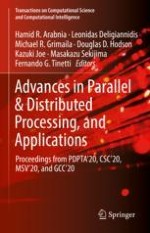The book presents the proceedings of four conferences: The 26th International Conference on Parallel and Distributed Processing Techniques and Applications (PDPTA'20), The 18th International Conference on Scientific Computing (CSC'20); The 17th International Conference on Modeling, Simulation and Visualization Methods (MSV'20); and The 16th International Conference on Grid, Cloud, and Cluster Computing (GCC'20). The conferences took place in Las Vegas, NV, USA, July 27-30, 2020. The conferences are part of the larger 2020 World Congress in Computer Science, Computer Engineering, & Applied Computing (CSCE'20), which features 20 major tracks. Authors include academics, researchers, professionals, and students.
Presents the proceedings of four conferences as part of the 2020 World Congress in Computer Science, Computer Engineering, & Applied Computing (CSCE'20);Includes the research tracks Parallel and Distributed Processing, Scientific Computing, Modeling, Simulation and Visualization, and Grid, Cloud, and Cluster Computing;Features papers from PDPTA’20, CSC’20, MSV’20, and GCC’20.
